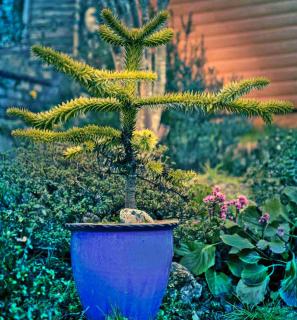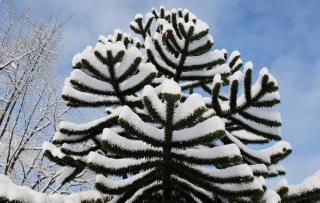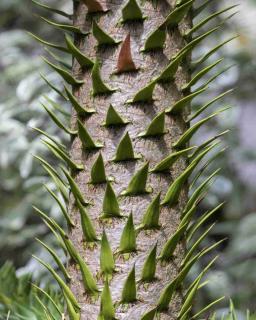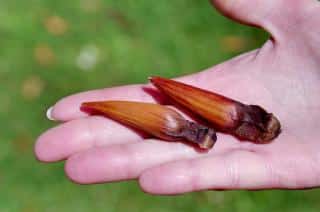

Araucaria araucana, or Monkey puzzle tree, is a surprising evergreen conifer that’s very ornamental.
Key facts to remember
Name – Araucaria araucana
Family – Araucariaceae
Type – conifer
Exposure – full sun or part shade
Soil – well draining, ordinary
Height – 30 to 45 feet (10 to 15 meters)
Flowering – spring
Foliage – evergreen
Growth – slow
The monkey puzzle tree is best planted around fall to give it the whole winter season to spread roots out, guaranteeing better health in spring.
Important: Araucaria araucana tolerates all types of soil, be they chalky or acidic, but it does require soil that is well drained where water won’t stay put.
Araucaria araucana is hardy to 10°F (-12°C), so it resists freezing and cold weather in winter. Araucaria araucana or monkey puzzle tree growth is relatively slow, even though when mature, it reaches heights of 30 to 45 feet (10 to 15 meters).
 It is perfectly possible to grow a monkey puzzle tree in a pot or container.
It is perfectly possible to grow a monkey puzzle tree in a pot or container.
Care is straightforward for Araucaria araucana, especially once it’s properly settled in.
Pruning isn’t actually recommended, especially since much of the appeal of araucaria araucana is its distinctive bearing, sometimes spiking up in a column, sometimes spreading to the sides. If you do need to prune it back, do so at the beginning of summer and avoid cutting back all the way to the trunk. It’s better to prune lightly than to cut it back too much. Note that lower branches will fall to the ground as the tree grows, this is perfectly normal.

When growing in a container or pot, water when the surface of the soil is dry, but without overdoing it. In a pot or garden box, give the plant conifer tree fertilizer in spring.
In winter, no need to water.
Propagation is typically done through seed. Pick cones from underneath specimens you find particularly elegant and symmetrical.
Best is if it comes from a similar to your own environment: climate, temperatures, rainfall. It will have passed on some of its “knowledge” to its children. Thanks to this, it will be more adapted to growing in your own garden! Epigenetics is the botanical term for this phenomenon.

Indeed, people at first thought that monkeys would never be able to climb up its branches since they’re covered with spikes… a puzzle for them to solve! Today, it’s a beautiful ornamental tree, occasionally spotted as a standalone in the center of a lawn, or in containers to the side of a deck or terrace.
